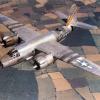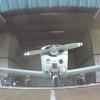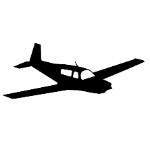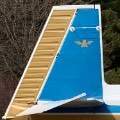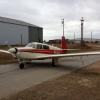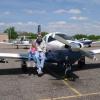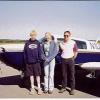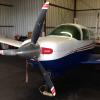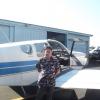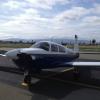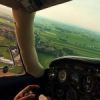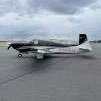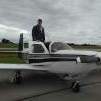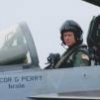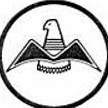Leaderboard
Popular Content
Showing content with the highest reputation on 08/20/2016 in all areas
-
The deal was finished up last night. N1972W is a 1962 M20C with 5700 tt and 600 SMOH. Yesterday I went up for a flight before closing, everything looked good. I ended up driving my rental car from Willmar MN to Flying Cloud airport where I managed to find an instructor while Tim, the broke flew her to flying cloud. Once there The instructor and I flew Tim back to Willmar and then turned around to head back to FCM. On the way back we had to land at Glencoe and wait out some heavy storms over Minneapolis. I did my first night landing and first bit of night cross country time! My dad, a Delta pilot, is flying out tomorrow afternoon to fly her back with me on Monday. He's flying a redeye from LAX to JFK the night before and then I'm going to make him deadhead to MSP and spend 5 hours with an instructor in N1972W. Her final home will be KLAM in New Mexico.6 points
-
You mean like this: Sent from my iPad using Tapatalk2 points
-
I ended up having the right side rebuilt in part to do away with the challenge of trying to work in those close quarters. From this: To this: Sent from my iPad using Tapatalk2 points
-
I've taken ownership of N1972W as of yesterday. Currently I have her parked at Elliot Aviation at KFCM because that's where the instructor is. I went ahead and made a new thread in the Vintage Mooney forum with pictures. Thanks again for all your help guys!2 points
-
Mcmaster.com - Part #: 6058K32 - $5.10 each You're welcome.[emoji846] Sent from my iPad using Tapatalk2 points
-
Ah, Philippians 4:11 "... for I have learned to be content with whatever I have." Not sure Paul could foresee airplanes though...2 points
-
I've been running Airhawks for almost 20 years on my Mooney. Been great. If I let renters fly the plane I might worry about spending more but as long as it's me lightly kissing the mains on Airhawks have been perfect. Can't see spending more -Robert2 points
-
Bubbling paint, visable corrosion, grease leaks, loose blades, dis colored grease, moisture in grease , ect!2 points
-
I believe the overhaul is really just for 135. The prop shops I've used will discourage owners from asking for the O word since it adds expensive without benefit. I've usually had mine opened when it's spraying it's grease down the blade or after my engine failure to remove all the excess metal. -Robert2 points
-
If you lose part or all of a blade in flight you should have the prop repaired. Otherwise just touch up the blades with Aluminum oxide sandpaper and grease the hub every few years. A little spray paint can make it look new again! 20, 30 even 40 years is nothing to a fine piece of precision machinery. If there's a little grease streaking the blades that means there's still some in the hub, a good sign. Fly on!2 points
-
I just tighten mine until they are snug. Never used Locktite on them. Sent from my iPad using Tapatalk1 point
-
Clearing up my thoughts... The C had the CBs distributed along the bottom edge of the IP all in a row. The F is a step more modern in comparison. Thanks to marauder for generously and photographically pointing out the differences. Best regards, -a-1 point
-
On our retractable gear, particularly if you change tire brands/models, be sure to jack the plane and cycle the gear a few times to be sure you have clearance. Not all tire are the same.1 point
-
1 point
-
Matt, are you replacing a few or all of them? I have the 60s vintage red "press to reset" CBs. I would love to swap them all out with the newer pull-types. I'll be watching your progress1 point
-
Turnout was good today! We had 12 people and 7 aircraft. My Missile, a Bonanza, Two J's, a C, E, and an Ovation! There was also a rotting B on the ramp (someone buy and restore her!) and a georgeous Acclaim parked on the other side of the ramp in the distance. Five of us went to the museum after breakfast and being airplane nuts, we all really enjoyed it. I think Alan may have opened every inspection panel on all the aircraft he could reach. They have a nice small museum at Wildwood/Cape May. The original tower from Bader Field is on display with steps to walk up. There are many aircraft ranging from WWII trainers to static display 4th generation fighters on loan from the Navy (F-14). They also have a lot of helicopters and a coast guard ship. Being that close to a TBM Avenger reminds me just how massive it is! I'll give better notice for next month. -Seth1 point
-
Congrats! Nice plane! Uhoh... You named her. BIG mistake!! Now you will go broke upgrading her!! Ask me how I know!! Lol!! Seriously, welcome to the club! Sent from my XT1254 using Tapatalk1 point
-
Yup, it happens to newbies and sometimes to veteran JBar folks. Try putting the gear down in a 2 (3?) step process: release from floor latch and allow the bar to come up a foot or so; pause, mindful of the seatbelt latch, ease the bar by the latch, and finish the process swinging the bar into the down&locked latch. About every 10 or 20 times without tripping the seatbelt you'll forget and get a reminder of your SOP. If that is not satisfactory the previous owner of my E had a Velcro strap around the seatbelt latch.1 point
-
Push button latches like are in automobiles are available. Check with Alpha. http://alphaaviation.com/Mooney.html1 point
-
I'm fairly certain this item matches up exactly with the broken part removed from my M20. To confirm you can call McMaster and request the OEM part number for the item (isn't shown on website). I just hate seeing people overpay for "stock" items. I love LASAR for Mooney specific parts and "advice" but they probably won't beat McMaster at $5.10.1 point
-
They are talking about a quick-disconnect for the cowl flaps not the regular cowl fasteners.1 point
-
For seat foam (Confor Foam) I can highly recommend these folks. Husband and wife, extremely nice people, I always make time to talk with them at Oshkosh. You can pick their brains for ideas and design your own seat foam. http://www.seatfoam.com/aviation.htm1 point
-
15 years of hot starts on my Rocket have been pretty much as Doc described, and I've tried a lot of methods others have suggested and always return to what has always been consistent. Full throttle and mixture full rich. Run boost pump for 6-7 seconds. Mixture all the way back to no fuel and prop at 1/2 throttle As it fires mixture in and throttle back to idle (a pretty quick dance). Always starts in about 6-8 seconds. I tried the low boost, as that's what works on the Bo I fly, but it just complicates a known start procedure (and if forgotten, you will not be able to kill the engine with a mixture pull). Don't ask how I know that (on the Bo). Tom1 point
-
Rest your feet on the rudders when it is bumpy. Sent from my iPad using Tapatalk Or let the PC take care of the rudder! [emoji3][emoji3][emoji12]Sent from my XT1254 using Tapatalk You'll lose your 39 true airspeed gain if you do that! Sent from my iPad using Tapatalk Crap!! Stupid PC system.1 point
-
That's most likely proprietary information, part of what sets them apart from the competition. On the other hand, please share what you do and how well it works. Eventually we will all hit in a combination that works for many of us. Won't be too long til mine are ready for new foam. They probably are already, I just disguise it with a gel pillow so I can see over the cowl.1 point
-
It is my understanding, based on pictures and my memory, that Oregon Aero uses two or three different densities and thicknesses in different places on the seat. That formula is what I would like to have.1 point
-
I had seats rebuilt this summer. New foam throughout. There's a thin top layer of comfort, then 1" of memory foam, then 1-2 inch more foam under that. The memory foam is good for long flight comfort. I hear that on cold days it stays hard for half an hour (no jokes, please) before it conforms to your, ah, contours. Winter will tell. Aside: Anyone have an STC for heated seats?1 point
-
1 point
-
If you've successfully launched and landed more than 10 times, then the first thing you should do is ignore the POH or Owners Manual and just fly what feels right. I use more take-off trim if I'm using flaps and less if I'm not using flaps. But regardless, push all the knobs full forward, and as soon as you're off the ground, raise the gear. Now with the gear tucked up, figure out what you want to do with trim, flaps, rate of climb, boost pump, etc. I'd always leave the power, prop, mixture full in unless it was hot and I had cooling issues. The first control to move for cooling is the prop. Back the RPM's down to 2500 and leave everything else full in. That usually keeps the C cool enough. On landing, I'm with Shadrach and Bob. If I'm coming in slow and steep with full flaps, I'll use full up trim. If no flaps with a long runway, I'll use a lot less trim. It's a simple airplane, just fly it the way it feels right and behaves well. And feel free to ignore the book.1 point
-
Nothing like a personal Airshow Sent from my iPad using Tapatalk1 point
-
They're here and more coming. Loved watching the B-25 land! Sent from my iPad using Tapatalk1 point
-
As Paul said, it's a difficult question to answer. If parts are needed, then those parts from Mooney or Continental are going to be expensive, parts from Spuce, not so bad. Getting the problem identified and fixed the first time saves a lot. Don Maxwell's shop in Texas is one of the best also Kerry MacIntyre out in Wyoming. I'm nowhere near there, but I've called them with questions, and they have always been very kind and helpful. As an example, my starter adapter was failing. The 'new style' which I have only last about 1000 hours. I called Continental and Niagra( very reputable business), both told me they would have to see mine to give an accurate quote, but told me it would be in the $6,000 range. Don referred me to a shop in Texas that overhauled mine for about 1k. Still working fine. I do my own annuals, as I am fortunate to have one of the world best a&p w/ ia as a friend. Last years annual with new tubes/ tires and brake pads was abut $2,000 and about 10 days. My advice is to get a set of maintenance manuals, if you find champion plugs, get rid of them and replace with tempest, and take the time to diagnose the problem and know your options before bringing it somewhere. BTW, the airframe is solid. I know that doesn't completely answer your questions, but that's all I got.1 point
-
Right you are. I'm doing my first owner assisted annual right now. I have no idea what I'm doing and I've already found problems that "Professionals" left behind. Nobody cares about the condition of my plane more than I do.1 point
-
the seats are not that hard to take apart and put new foam in. say half a day start to finish. It was a full day to resew a leather cover. In the better walley worlds they have seat foam in the crafts department. no need to suffer1 point
-
Once again this community has been invaluable to me! I now have the correct boost pump installed and the correct fuel pressure gauge and can now move on to cosmetics and make the airplane look pretty. THANK YOU ALL.1 point
-
1 point
-
IRAN that Sucker. Your not part:135 Its your Propeller, it should be your choice. Grease leak is a sign of Hard seals or Over serviced!!! To fix that, an O/H is way to evasive.1 point
-
1 point
-
OMG, YIKES Brian! Thanks for sharing, and glad you're still with us!! That is a horrifying picture. I may need to go the airport, un-cowl my plane, and trace all my fuel lines before I can get to sleep tonight!!1 point
-
There is an adjustment on the Brittian Gyro... Uses a small screw driver to change. The MSC should know this. Brittian will be able to tell you how to adjust However, roll trim knob position may vary as much as 90° from center without indicating a faulty system. http://www.67m20e.com/Manual No. 11990 Mooney PC Operation and Service Instructions.pdf There can be a bit of P factor that requires a bit of right rudder to keep the ball centered at full power1 point
-
Mike the foam is awesome, I also find that my sheepskins added a nice measure of comfort. My good friend has a Bo, another C-310, and Cardinal. In my opinion which is the only one that matters the Bravo is by far the most comfy for me and bride. That's with five hour legs.1 point
-
Entry & exit are the only real issues I see. My wife makes her exit look very graceful from the co-pilot seat by swinging her legs and sliding out along the leading edge of the wing and gently landing on her feet there in front of the wing...but she makes it look good even when it's not graceful! Sitting beside my wife is where I kinda want to be touching elbows, if you know what I mean. It's all about mission. Recently took my 6'4", 230-lb brother and his two sons up for an hour of sightseeing around the Grand Coulee Dam. His sons are 10 & 14-yrs of age and I'm no cream-puff at 6'1" and 175-lbs...albeit, we were light on fuel and I emptied out the extra stuff in the baggage area, we were still easily within the CG limits for the airplane and landed with over 20 gallons of fuel remaining. And we were quite comfortable in flight I might add...certainly no complaints as my pax were doing nothing but GRIN! Good memories and the Mooney worked it's magic again!!1 point
-
I used to use the most expensive shops around including several Mooney service Centers. Then I started noticing overlooked problems that were actually scary. So I do my own work because I can feel safer when my family and I are out over the sea of Cortez. -Robert1 point
-
1 point
-
You might also want to consider an IO-550 equipped mooney. Missile, Eagle, or Ovation. You'll get much better speed than a 231 down low and as good up to O2 required altitudes. Oh and none of the maintenance headaches associated with forced induction.1 point
-
1 point
-
Don't touch the brakes until the flaps are raised. I'll just run go put my flame suit on now ... ;-)1 point
-
1 point
-
Do you raise the right flap or lower the left? You won't know but the rigging boards can help. A rough guess is the ailerons are at zero when the counterweight is faired. Fair the flaps to that and it's approximately zero.1 point
-
In my experience, Harley riders are one of the most diverse group of motorcyclists. In terms of intellect, they have solid representation across the whole bell curve. Putting Kerosene in a V-Twin proves that this guy resides in the lower left hand part of the graph.1 point

